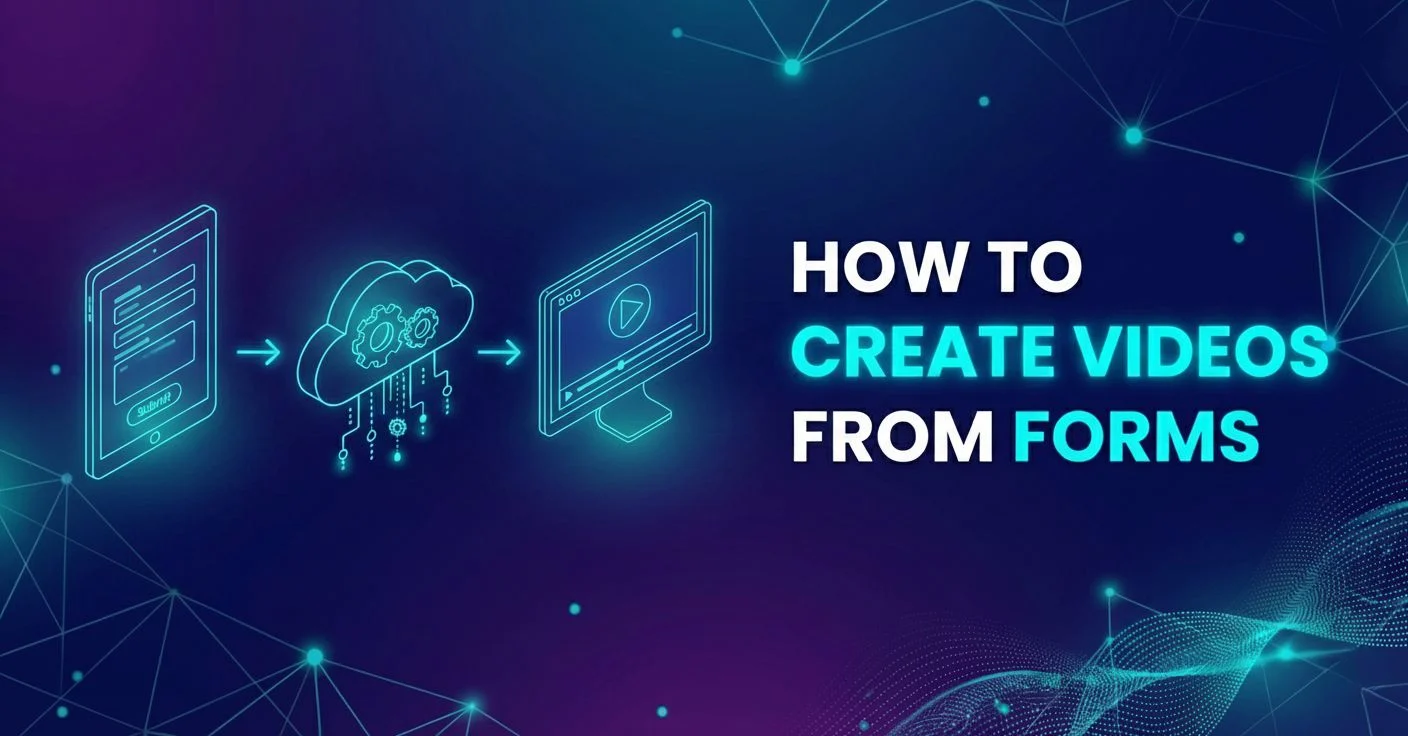10 personalized ads examples
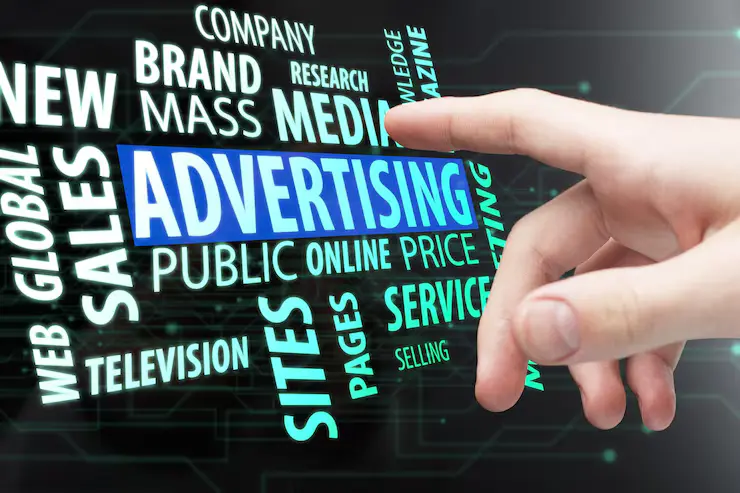
Personalized ads examples are everywhere, from that Spotify playlist you didn’t know you needed to the eerily accurate hotel suggestion in your inbox.
But what exactly are they?
Personalized ads are marketing campaigns that feel as if they are made specifically for each individual. Notice how we said feel? That's because they weren't made one at a time. Rather, they were created using data (e.g., browsing behavior, purchase history, demographics, even real-time location) to dynamically adapt messaging for different people at scale, and thus craft personalized experiences.
Now, why bother with such ad campaigns to begin with when it’s much easier to run traditional ads and be done with it? Easier? Yes. Better? Absolutely not.
It’s simple. If your ads aren’t personalized in this day and age, you can’t expect them to resonate and provide real results. That’s because most of the content nowadays looks and feels the same, courtesy of AI. Algorithms pump out more of it than ever, but creativity? Not so much. People are tired of the generic. Add in a post-pandemic world where doomscrolling became a national sport, and it’s no surprise our attention spans have taken a nosedive. In fact, at an 8-second average, our capacity to retain attention is worse than that of a goldfish!
People crave uniqueness. And personalized ads provide exactly that. When people feel as if something was made for them and them only, they’re more likely to notice it, engage with it, and remember it.
And the numbers agree, with the research from McKinsey backing it all up:
- 76% of consumers say personalization makes them more likely to consider a brand
- 78% are more likely to repurchase from brands that personalize
- Brands that get it right see 10-15% revenue growth on average.
So as you can see, it’s high time you jumped on the personalized ads wagon. And if you’re looking for inspiration for your next campaign, this is the place to be.
Below, we’ve rounded up 10 best personalized ads examples that we personally think are smart, creative, and just the right amount of bold. You’ll see how brands like Amazon, Coca-Cola, Decathlon, and more made personalization work, and why you should take a page out of their playbook. Don’t worry; we won’t tell. ;)
1. Amazon personalizes the shopping experience like it’s reading your mind
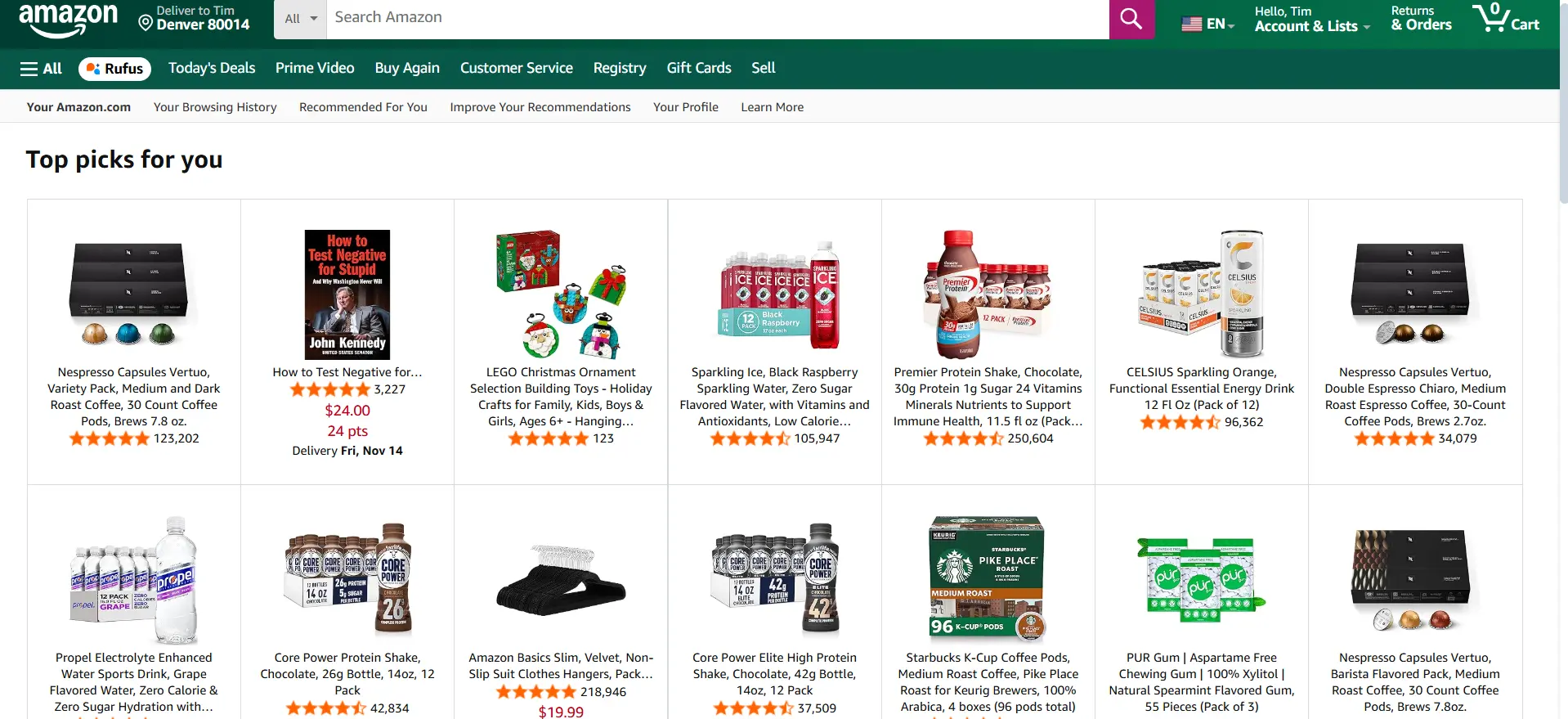
When it comes to personalized ads that drive revenue, few do it better than Amazon.
What they did:
Amazon turned product recommendations into a science, and then some.
Their system doesn’t only suggest what’s related to what you last bought. It analyzes your entire digital footprint. That includes your browsing history, past purchases, session times, click depth, and even what similar customers have purchased. The goal? To surface products you didn’t even know you wanted, until Amazon put them in front of you.
Why it worked:
If we’re being completely frank, shopping on Amazon without personalized product recommendations would be overwhelming. With millions of listings, finding the right products at the right time would feel like digging through digital chaos.
But Amazon flips that. Instead of making you search, it curates. The homepage becomes a reflection of your own preferences, gently nudging you toward things that actually make sense for you. It makes the whole customer experience feel helpful rather than intrusive.
And more importantly? It makes shopping addictive.
Results:
Amazon’s recommendation engine is responsible for a jaw-dropping 35% of total revenue. That’s billions, yes, with a “b”, generated just by showing people the right thing at the right time.
2. Spotify Wrapped transforms listening habits into a cultural moment
Spotify Wrapped isn’t what you’d expect from personalized video ads examples. It’s not even an ad, to be completely frank, but it’s arguably one of the most iconic hyper-personalization examples done right, and thus, deserves a spot on the list.
What they did:
Launched in 2015, Wrapped takes each user’s listening data - including top artists, favorite songs, genres, minutes streamed, and more - and turns it into a colorful, animated recap of their year in music. It’s delivered as a sleek, swipeable story, complete with bold visuals, cheeky captions, and shareable slides built for social.
But Spotify Wrapped is so much more than a recap. It’s a digital trophy case. A badge of honor. A way for people to signal identity through the music they love. And because it’s designed with virality in mind, it becomes the campaign of the season every single year.
Why it worked:
Spotify Wrapped hits the perfect sweet spot between data and emotion. It’s personal, nostalgic, and fun, which is everything a static ad isn’t. More importantly, it makes users the main characters of the campaign. Wrapped doesn’t market to people - it markets through them.
Wrapped is also ridiculously viral. It gives people something to show off (hello, top 0.5% of Taylor Swift listeners) and a reason to talk about the brand on social media… all while doing zero traditional advertising.
Results:
Spotify Wrapped caused a 21% spike in app downloads during its 2020 release week. It also trends globally on social platforms every year like clockwork and strengthens brand loyalty by celebrating user's unique tastes. And that? It keeps people coming back for more - year after year after year.
What if we told you… you could create something like Wrapped, too?
That’s right. Spotify Wrapped-style videos aren’t just for billion-dollar brands! With Plainly Videos, you can turn your data into dynamic content that’s fully personalized, fully scalable.
Watch how to do it in this quick demo.
3. Netflix thumbnails that quietly sell you on what to watch
We all know Netflix tailors recommendations based on previous watch history. What most people don’t know, though? They also personalize how these recommendations look.
What they did:
For every show or movie, Netflix creates multiple thumbnail variations. Then, based on your viewing habits (genre preferences, favorite actors, even which thumbnails you’ve clicked in the past), it dynamically selects the image you’re most likely to respond to.
Now, say you like to binge on action movies. In that case, your thumbnail for a film might show an explosion or a tense chase scene. Prefer comedies? You’ll probably see a smiling lead character or a lighthearted moment instead. Yes, for the exact same movie.
Why it worked:
Netflix found that thumbnails influence over 80% of what users decide to watch. And by making them hyper-relevant to each viewer, they reduce the friction between scrolling and streaming. You don’t think you're being persuaded. You just feel like you made the right pick. That’s personalization at its most invisible, and most effective.
Results:
Netflix reported that users respond significantly better to personalized thumbnails, with some sources estimating a 30% boost in click-through rates compared to static, one-size-fits-all images. That means more watches, more retention, and more time spent on the platform. All that from changing a single frame. Not bad, huh?
4. Marriott rewards turned loyalty points into personalized marketing magic
You’ve seen loyalty programs that offer points. But Marriott figured out how to turn those points into personalized, high-impact video ads that made each member feel like a VIP in the process.
What they did:
Marriott wanted to drive engagement for Marriott Rewards Moments - exclusive experiences that members could redeem using their Marriott Bonvoy points (VIP concert seats, backstage passes, celebrity dinners, etc.).
So, they built a personalized video marketing campaign targeting their Elite members on Facebook. Using a custom API connected to their loyalty platform, they automatically generated 15-30 second dynamic video ads based on each member’s point balance and preferences.
Every ad showcased 3 curated Moments the member could redeem right now and refreshed every 8 minutes to stay up to date. Over 1 million unique video variations were rendered during the 5-week campaign.
Why it worked:
These ads were perfectly timely, relevant, and actionable. Instead of vague loyalty messaging, Marriott showed users the exact experiences they could unlock with the points they already had. It turned passive members into engaged redeemers by tapping into real-time FOMO.
Results:
The campaign crushed benchmarks. Click-through rates jumped 250%. Reward redemptions increased 60%. Site visits were up 81%, and dwell time beat industry averages by 33%.
5. NESCAFÉ Dolce Gusto x Snapchat brings the coffee shop to your living room
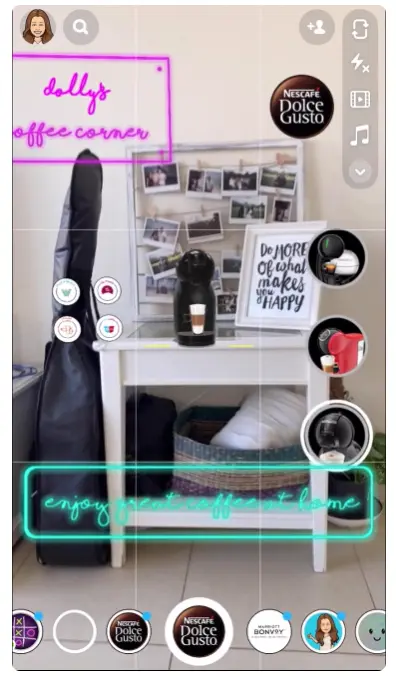
Ever wish you could test a product before buying it, without leaving your couch at that? NESCAFÉ figured out how to make that happen.
What they did:
To launch their Genio S Plus machine in the MENA region, NESCAFÉ Dolce Gusto partnered with the mobile app, Snapchat, to create a personalized AR experience. Users in Saudi Arabia, UAE, and Kuwait could build their own virtual coffee corner using an interactive lens, placing the machine in their home environment to see how it’d look IRL.
But this wasn’t just a fun little filter. It was part of a smart performance campaign. The lens was tied to dynamic product ads that encouraged users to learn more and buy.
Why it worked:
The experience felt seamless, relevant, and real. By letting people visualize the product in their own space, NESCAFÉ gave them a reason to care and act.
Results:
The results brewed up nicely (pun intended). The campaign reached 6.2 million people across Snapchat. Out of those, 2 million used the AR lens to see the machine in their space. But it didn’t stop there - brand awareness increased by 14 percentage points, ad recall went up by 16 points, favorability by 5 points, and purchase intent by 6 points. All from one personalized AR experience that made morning coffee feel a little more futuristic.
6. Decathlon used personalized video ads to win over a new market
Breaking into a new territory is hard, especially when you're up against big names like Nike and Adidas. But Decathlon figured out a way to stand out.
What they did:
When Decathlon entered the Singapore market, they had a problem: no brand recognition. So, they partnered with Google in 2019 and launched a two-part personalized marketing campaign designed to drive both online and in-store conversion rates.
The first part used YouTube’s standard TrueView ads to target people actively searching for sports gear.
But the second part is where the ad personalization magic kicked in. Using YouTube Director Mix, they dynamically generated 100+ video ad variations based on users' search behavior. Each video highlighted products relevant to that specific viewer. This means someone searching for “yoga mat” didn’t see a generic Decathlon ad. They saw a video showing yoga mats specifically.
Why it worked:
The ads felt highly relevant and timely, like they were made just for the person watching. By combining smart targeting with automated video personalization, Decathlon skipped the fluff and showed people exactly what they were looking for.
Results:
The campaign delivered serious wins, including:
- 175% increase in online conversions
- 51% higher return on ad spend
- 28% boost in in-store foot traffic
Now, if you were to borrow Decathlon’s approach, you’d have a small problem: YouTube Director Mix, a tool they used for the campaign, isn’t commercially available.
There is, however, a tool that can help you achieve the same results - Plainly.
Plainly is the ultimate personalized video marketing solution that lets you create personalized videos at scale without needing Google-level access. You build a video template with dynamic layers for things like text, images, audio, and colors in After Effects. Then, upload it to Plainly, plug in your data source (you can go from a spreadsheet to video or use an API), and automatically render countless versions of the ad based on that same data.
The result? Yoga lovers see ads promoting yoga mats. Runners see running shoes. See? Just like Decathlon, minus the red tape.
7. Coca-Cola made a mass product feel one-of-a-kind
Talk about one of the most well-known personalized ads examples - Share a Coke!
What they did:
With Share a Coke, Coca-Cola did something surprisingly simple and wildly effective. They swapped out their iconic logo on bottles and cans with common first names. Just like that, a mass-produced drink suddenly felt personal.
The idea was to create a moment of emotional connection. Spotting your name on a Coke bottle felt like the brand was talking to you. People started hunting for their names in stores, gifting bottles to friends, and posting their finds online like trophies.
Why it worked:
This campaign didn’t rely on fancy tech or layers of customer data. It worked because it made people feel seen. And when something as big as Coca-Cola feels personal, it creates a powerful moment. Add in the shareability factor (because who doesn’t want to flex their name on a can?), and you’ve got a recipe for viral brand love.
Results:
The campaign rolled out globally, and the numbers fizzed with success. In Australia, young adult consumption jumped by 7%. In the U.S., sales of personalized bottles went up by 11%. And online? Facebook traffic spiked 870%, and over 150 million named bottles were sold worldwide.
All from one small tweak that made every Coke feel like your Coke.
8. Mars and Amazon turned everyday wins into sweet rewards
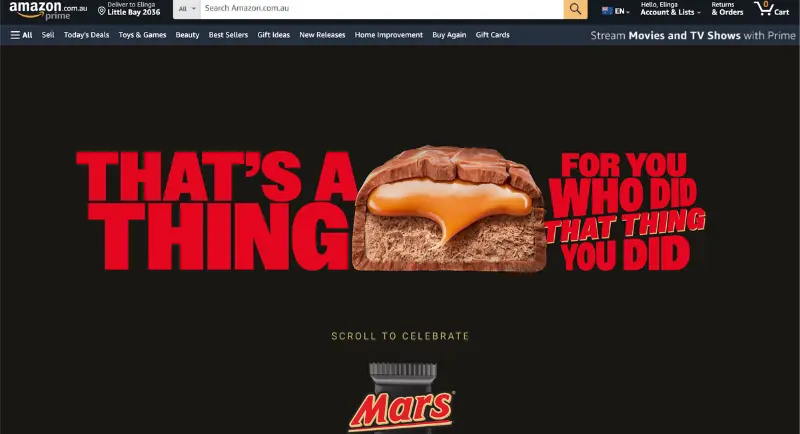
Slapping a name on a bottle and adjusting product recommendations surely counts as personalization. But so does recognizing the small stuff people do every day and making them feel like that matters. Which is exactly what Mars and Amazon did.
What they did:
In 2023, Mars teamed up with Amazon Australia to launch a playful, AI-driven campaign called ‘’For You Who Did That Thing You Did.’’ The idea was to celebrate the often-overlooked, everyday victories people accomplish, from sorting the spice rack to surviving leg day at the gym.
Shoppers on Amazon.com.au were prompted to submit “things” they’d done that day, anything they felt deserved a little reward. Amazon Bedrock, the generative AI engine powering the campaign, would scan the submissions in real time. If your “thing” qualified, you got a surprise Mars bar in your next Amazon order. That’s right, real candy, delivered with your package, just because you alphabetized your bookshelf or finally finished your tax return.
But the campaign didn’t stop at candy drops. Mars pushed personalized creative across Amazon Prime Video, display ads, homepage placements, packaging, and even customer emails, each crafted to reinforce the reward moment and meet customers at every touchpoint.
Why it worked:
Mars took a simple truth - You deserve a reward - and made it feel uniquely personal. The campaign acknowledged individual effort, no matter how small, and turned that into a branded moment of joy. It was emotional, clever, and scalable thanks to AI, making it feel custom without much manual effort.
Results:
Mars saw a 4.3% bump in offline sales as a result of the campaign, a 67% increase in Amazon sales, and a 4.8% lift in ad recall. Even more impressively, 60% of brand store visitors were new-to-brand, and the email open rate hit 57%, well above industry norms.
It also landed with a typically hard-to-reach crowd - Gen Z and young adults - driving strong gains in both brand favorability and recall, and proving that personalization doesn’t have to be complicated to be memorable.
9. Lidl let the internet design its next product - and people went wild
Most personalized ads examples have got the brand in control of advertising. But Lidl flipped that script and handed the reins to the audience.
What they did:
In 2024, Lidl France teamed up with the agency Marcel and GenAI company Bria to launch Lidlize - an interactive platform that let anyone create a branded product with Lidl’s iconic red, blue, and yellow look.
You didn’t need to know how to prompt an AI or use complex tools. Just type in any object - bucket hat, toaster, waffle maker shaped like a cat - and Lidlize instantly returned a professionally designed version in full Lidl glory.
Here’s where it got really clever: the most liked designs had the chance to become actual Lidl products. So, users weren’t merely playing with a tool. They were pitching ideas to the brand itself.
Why it worked:
The UX was frictionless, and the incentive was irresistible. Not to mention, the whole thing felt more like a game than a campaign, but that’s what made it stick.
Behind the scenes, Lidlize ran on a lightning-fast GenAI engine that could process up to 1,000 requests a minute. It also translated French inputs into English automatically to maintain consistency across the board.
Results:
In just 3 weeks, Lidlize generated 1.7 million AI-created images, with peak moments hitting 1,000 image requests per minute. Each one rendered in just 2 seconds, keeping things fast, fun, and frustration-free.
Thanks to Bria’s fully licensed model, every image was also legally safe and on-brand, which is a big win for compliance in the GenAI era.
10. Cadbury showed that automation can be personal, too
Cadbury may be known for comfort food, but when it came to digital strategy, they pulled off a campaign that was anything but basic.
What they did:
To promote Cadbury Fuse in India, the brand launched a highly targeted campaign called “Don’t Go Far for Hunger.” They wanted to show people that the perfect snack is already nearby, and do it in a way that felt connected to their lives.
They created a modular framework that combined:
- 8 audience passion points (cricket, Bollywood, Game of Thrones, and more),
- 6 dynamic elements (including real-time data like time of day and day of the week),
- 63 different geolocations across the country.
Using automation and dynamic creative optimization (DCO), these inputs were stitched together to generate a whopping 92,000 unique targeted ads variations, each one customized to the viewer’s interests, habits, and location.
Why it worked:
Cadbury didn’t try to force one message to fit everyone. Rather, they let the data do the work. Someone watching cricket on a Sunday afternoon in Mumbai got a completely different experience from someone bingeing GoT on a weekday evening in Delhi.
This level of personalization made the ads feel more relevant and, yes, snack-attack worthy. More importantly, automation made it scalable.
Results:
The ads were a massive hit and delivered:
- 80 million impressions
- 2.6x higher click-through rate than the CPG benchmark
- 50% boost in ad recall
And all with reduced creative development and tracking time.
Personalized ads examples are only as good as the tools behind them
You’ve just seen what happens when brands ditch generic campaigns and make things personal. From billion-dollar engines like Amazon’s recommendation system to wildly creative stunts like Lidlize, it’s clear: relevance wins.
And while some of these personalized ads examples required Google partnerships and global ad teams to pull off, that doesn't mean you can't successfully recreate them. As a matter of fact, with Plainly, you can create personalized videos at scale. No coding experience needed!
Build one smart template. Connect your data. Hit render. That’s it.
If you’ve got customer data and marketing messages worth hearing, you’re already halfway there. Now make it personal.
Start your 14-day free trial or book a demo to see how Plainly can turn your next campaign into one worth remembering.




